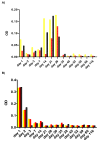Characterization of chronic HCV infection-induced apoptosis
- PMID: 21781333
- PMCID: PMC3160349
- DOI: 10.1186/1476-5926-10-4
Characterization of chronic HCV infection-induced apoptosis
Abstract
Background: To understand the complex and largely not well-understood apoptotic pathway and immune system evasion mechanisms in hepatitis C virus (HCV)-associated hepatocellular carcinoma (HCC) and HCV associated chronic hepatitis (CH), we studied the expression patterns of a number of pro-apoptotic and anti-apoptotic genes (Fas, FasL, Bcl-2, Bcl-xL and Bak) in HepG2 cell line harboring HCV- genotype-4 replication. For confirmation, we also assessed the expression levels of the same group of genes in clinical samples obtained from 35 HCC and 34 CH patients.
Methods: Viral replication was assessed in the tissue culture medium by RT-PCR, quantitative Real-Time PCR (qRT-PCR); detection of HCV core protein by western blot and inhibition of HCV replication with siRNA. The expression level of Fas, FasL, Bcl-2, Bcl-xL and Bak was assessed by immunohistochemistry and RT-PCR whereas caspases 3, 8 and 9 were assessed by colorimetric assay kits up to 135 days post infection.
Results: There was a consistent increase in apoptotic activity for the first 4 weeks post-CV infection followed by a consistent decrease up to the end of the experiment. The concordance between the changes in the expression levels of Fas, FasL, Bcl-2, Bcl-xL and Bak in vitro and in situ was statistically significant (p < 0.05). Fas was highly expressed at early stages of infection in cell lines and in normal control liver tissues followed by a dramatic reduction post-HCV infection and an increase in the expression level of FasL post HCV infection. The effect of HCV infection on other apoptotic proteins started very early post-infection, suggesting that hepatitis C modulating apoptosis by modulating intracellular pro-apoptotic signals.
Conclusions: Chronic HCV infection differently modulates the apoptotic machinery during the course of infection, where the virus induces apoptosis early in the course of infection, and as the disease progresses apoptosis is modulated. This study could open a new opportunity for understanding the various signaling of apoptosis and in the developing a targeted therapy to inhibit viral persistence and HCC development.
Figures






Similar articles
-
Fas / FasL system, IL-1beta expression and apoptosis in chronic HBV and HCV liver disease.J Viral Hepat. 2008 Jul;15(7):515-22. doi: 10.1111/j.1365-2893.2008.00974.x. Epub 2008 Mar 6. J Viral Hepat. 2008. PMID: 18331250
-
Autophagy and apoptosis-related genes in chronic liver disease and hepatocellular carcinoma.BMC Gastroenterol. 2012 Aug 28;12:118. doi: 10.1186/1471-230X-12-118. BMC Gastroenterol. 2012. PMID: 22928777 Free PMC article.
-
Induction of FAS ligand expression in a human hepatoblastoma cell line by HCV core protein.Virus Res. 2003 Nov;97(2):103-10. doi: 10.1016/j.virusres.2003.08.004. Virus Res. 2003. PMID: 14602201
-
Novel pregnenolone derivatives modulate apoptosis via Bcl-2 family genes in hepatocellular carcinoma in vitro.J Steroid Biochem Mol Biol. 2018 Oct;183:125-136. doi: 10.1016/j.jsbmb.2018.06.006. Epub 2018 Jun 10. J Steroid Biochem Mol Biol. 2018. PMID: 29898413
-
The Role of Bcl-xL Protein in Viral Infections.Int J Mol Sci. 2021 Feb 16;22(4):1956. doi: 10.3390/ijms22041956. Int J Mol Sci. 2021. PMID: 33669408 Free PMC article. Review.
Cited by
-
p53 controls hepatitis C virus non-structural protein 5A-mediated downregulation of GADD45α expression via the NF-κB and PI3K-Akt pathways.J Gen Virol. 2013 Feb;94(Pt 2):326-335. doi: 10.1099/vir.0.046052-0. Epub 2012 Oct 31. J Gen Virol. 2013. PMID: 23114628 Free PMC article.
-
Antiviral Activity of Chitosan Nanoparticles Encapsulating Curcumin Against Hepatitis C Virus Genotype 4a in Human Hepatoma Cell Lines.Int J Nanomedicine. 2020 Apr 22;15:2699-2715. doi: 10.2147/IJN.S241702. eCollection 2020. Int J Nanomedicine. 2020. Retraction in: Int J Nanomedicine. 2022 Jul 05;17:2891-2892. doi: 10.2147/IJN.S380656. PMID: 32368050 Free PMC article. Retracted.
-
Serum apoptosis markers related to liver damage in chronic hepatitis C: sFas as a marker of advanced fibrosis in children and adults while M30 of severe steatosis only in children.PLoS One. 2013;8(1):e53519. doi: 10.1371/journal.pone.0053519. Epub 2013 Jan 11. PLoS One. 2013. PMID: 23326448 Free PMC article.
-
Hepatitis B and C virus-induced hepatitis: Apoptosis, autophagy, and unfolded protein response.World J Gastroenterol. 2015 Dec 21;21(47):13225-39. doi: 10.3748/wjg.v21.i47.13225. World J Gastroenterol. 2015. PMID: 26715805 Free PMC article.
-
Intrahepatic mRNA Expression of FAS, FASL, and FOXP3 Genes Is Associated with the Pathophysiology of Chronic HCV Infection.PLoS One. 2016 May 31;11(5):e0156604. doi: 10.1371/journal.pone.0156604. eCollection 2016. PLoS One. 2016. PMID: 27243827 Free PMC article.
References
-
- Eassa S, Eissa M, Sharaf SM, Ibrahim MH, Hassanein OM. Prevalence of hepatitis C virus infection and evaluation of a health education program in el-ghar village in zagazig, egypt. J Egypt Public Health Assoc. 2007;82(5-6):379–404. - PubMed
-
- El-Karaksy HM, Anwar G, Esmat G, Mansour S, Sabry M, Helmy H, El-Hennawy A, Fouad H. Prevalence of hepatic abnormalities in a cohort of Egyptian children with type 1 diabetes mellitus. Pediatr Diabetes. 2009;1(7):462–70. - PubMed
LinkOut - more resources
Full Text Sources
Research Materials
Miscellaneous
